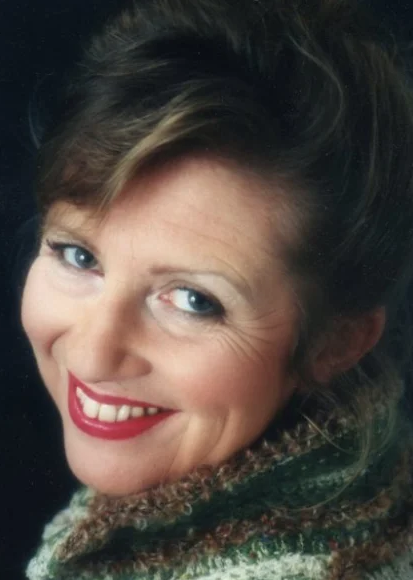
Tagged: knit knitting machine designer Anne Lavene House of Lavene Canterbury Beaney Lovelli interview
Hello Annie!
Hello Sue!
Tell me about what you do?
I knit on a single bed knitting machine and I have been doing this for just under 37 years. I make clothes to a shape, so that when they are hand-crocheted together they make garments that really fit people.
I started off by making a duffle coat for my three year old. I took him to play school, someone remarked on it and said “make me one,” and I’ve been doing it ever since! So it was just a garment that someone liked. It was a block pattern, simple. They hadn’t seen anything like it before and it looked different, so I made one and got paid for it. So it carried on. “Can you make my daughter a skirt?” I’d work out the pattern for that, and I’d make the skirt. So, it was children’s clothes first as my children were growing up. I was also wearing the odd things that I was making for myself, which people liked, so I literally sold off my back!
Yes, I’ve noticed that. When I’m out with you people stop you and remark on your clothes.
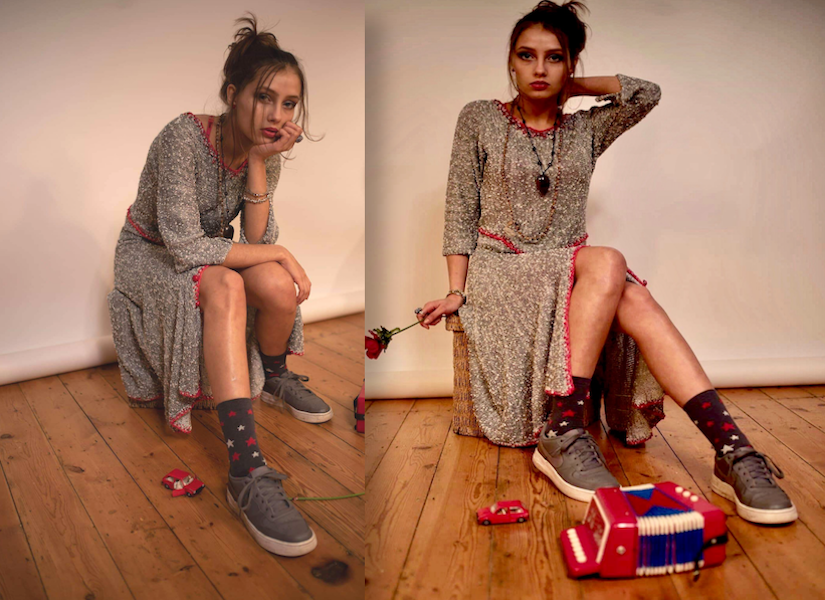
Yes, “Where did you get it from?” they ask. I get it all the time. And it happens to clients too! That’s how most of my orders have come about, through my clients – they are my shop window because they are actually wearing the clothes that I’ve made them in practical situations – at the office, parties or wherever they wear them. They’ve hosted house parties where they’ve had their friends round and I’ve taken loads of garments for them to try on. It’s being with people as opposed to just a rail of clothes.
I make them made to measure – that’s an important thing too, that there is no sizing involved. It’s about that person’s measurements, so I’ve learned how to make clothes fit people.
And presumably colours as well?
Well exactly. Different colours suit different people. Over the years I’ve developed an eye for what is going to suit and what is going to go together so I present clients with a shade card, with a main colour and contrasts, so that helps as well. In fact generally people don’t know what colours go together or what they want so often I’ve needed samples for them just to see. When they’ve got something to see, to physically try on then you’re more than halfway there.
I know Annie that you’re interested in passing on some of your skills to other people to help them start up. So what made you get into it?
Basically I did a tailoring course, including doing pattern cutting so I had an eye for shape. I’d always made clothes before, fabric clothes. I hadn’t much money, just bought fabric and made patterns and just made things fit me. So, I suppose without really realising it that was part of my training – I was able to turn two jumble sale dresses into a frock within a day or a couple of days. But, then having children young as I was, I realised that everything about sewing is dangerous for children. There’s the whole electric sewing machine, the needles, the pins, everything that goes with tailoring is actually not good to have lying around. My mother gave me a knitting machine and I suddenly realised that on this machine I could combine different yarns so not only can you make the shape of the garment but you are actually making the fabric. That’s the one – you can be a pattern cutter and a tailor but you still have to go and buy the fabric. You’ve got to find, to source the fabric. And fabric is expensive. Even then it was more expensive comparatively so I’d get old clothes and remake them. That was the thing that gave me the buzz, that this simple knitting machine that’s not electric could create amazing fabrics. By casting on and by creating a shape and by feeding in different colour yarns you’re actually doing the whole story you’re actually making the fabric as well, to shape. That’s got an amazing benefit because it’s all contained within the one machine, the one space and then when your child wakes up or you have to do something else you can cover the whole thing with a sheet and you can walk away from it. You haven’t got to put anything away.
When the kids started going to playschool, I’d grab a couple of hours and I’d sit at the knitting machine and sometimes I’d complete a whole garment or half a garment and then finish it the next day. Then in the evenings, because knitting machines aren’t sociable, they’re noisy, (as my family have told me over the years) I’d crocheting the knitted shape together to create the garment. When you’re concentrating on the knitting you don’t hear the noise, that swishing sound.
So that’s the important element, you’re creating the fabric and the shape and instead of sewing it you’re crocheting it together so there’s still the no sewing machine.
I appreciate what hand knitters say that it’s nice that you can sit and hand knit something in front of the television or it’s sociable because it’s not noisy and you can knit and natter and chat and all that but crocheting is the same and I use it as a way of finishing things.
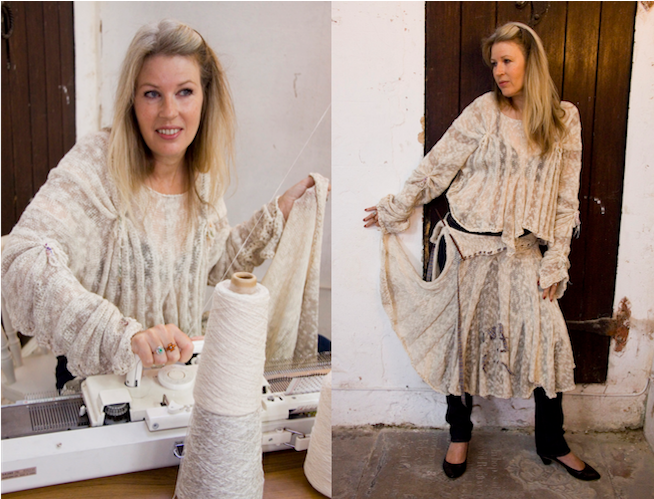
The other thing that I tried to avoid was joining things on the sewing machine because you’ve always got a seam which means you got a right side and a wrong side. I realised that by crocheting something together the garment becomes reversible.
And that is really one of the important parts of your garments – that you can wear them inside out, upside down, back to front.
Yes, that’s my USP if you like! For young children, it’s no problem – you can turn it inside out because the kid’s spilt something down its front – I’ve even done it for myself! Turn it inside or out or wear it the other way! Often if you combine yarns you can get a different look on both sides so it’s like two garments in one.
So, I was just coming up with patterns for garments that were relatively easy to manufacture, but were also really flattering shapes too.
And that’s where your tailoring background comes in – because you really know what works?
Yes!
You just mentioned patterns and I know that one of the things you’re into at the moment is making patterns that other people can use so that they can re-create a House of Lavene look – using a revolutionary non-word approach to it?
Exactly!
Basically, it’s not revolutionary to me because it’s how I’ve always done it. It started off again with the children. On a knitting machine every time you take the carriage from left to right or right to left you’ve got a row counter and it counts the number of rows automatically for you. And as a three year old, my eldest son realised that to get my attention all he had to do was to change my row counter. So if I sat back down at my work and the numbers didn’t correlate with my written pattern then I’d have to recount all the rows and he’d definitely got my attention. So, to stop me losing my place I started drawing the patterns like a dress pattern, as in a shape. I added just small multiples of numbers wherever there was a change and I also realised that this was an easy way for me to reproduce a particular style and adapt it really quickly.
So, I’ve always knitted, for my clients – they’ve always had their own… in the sewing world it’s called a toile… they’ve always had their own block, their own shape that I can make in different colours and so on. So, I found that it’s just an easy way, it’s a visual way as opposed to rows of text. Because if you’re looking at lots of rows of text to tell you how to complete a task then you never get a visionary idea of where you are. It’s always written row by row and you never get a sense of shape. You don’t know what you are making, you are just following a load of text. If you start off with a shape you can see how it’s supposed to be at least and it’s much easier to adapt. And to find your place when you’ve been distracted!
I’m a very visual person and I find it makes a lot of sense when I see one of your patterns – you can see what you are approaching…
…and where you are. So if you away from that particular design and then come back then it’s not rocket science – you can see the shape that’s hanging on the machine and see the picture that is in front of you and you can look at the row counter so you know, at any point exactly where you are.
Regarding the patterns, it also makes it a simple way for people to learn. Several people who I have taught and who are now knitting their own clothes and running their own businesses have found that effectively they learned pattern cutting without having to go to college or without having any formal training – they just found their way through it because of the visual nature of my patterns.
One of the other things that you’ve mentioned before is about no seams. No shoulder seams.
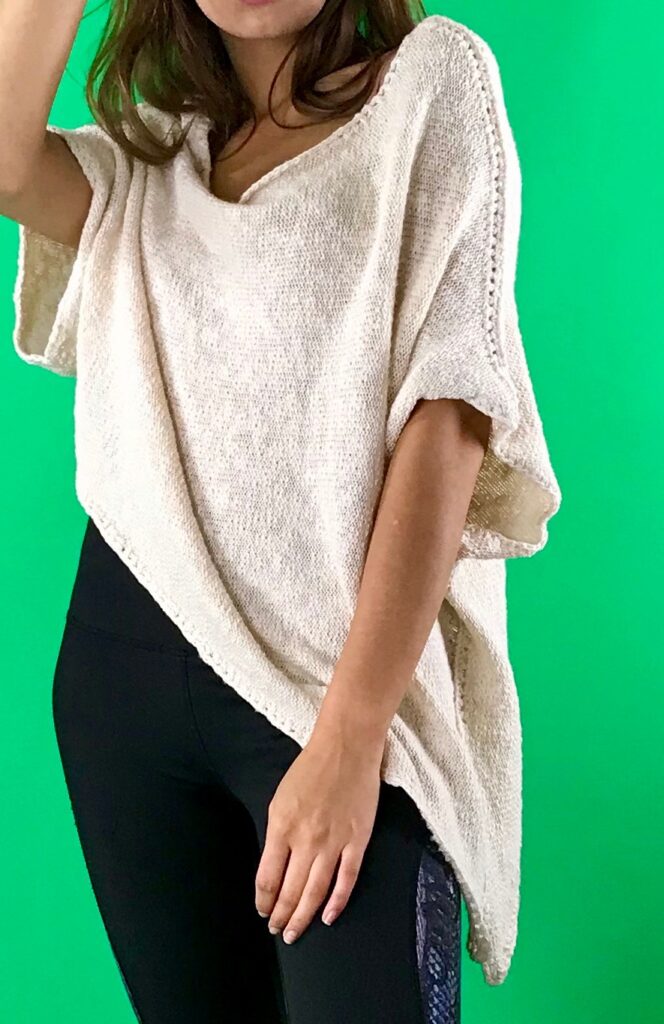
Well, some of my designs have shoulder seams but basically, as a pattern cutter at the beginning, I’ve always been attracted to bias cut things which means that a shape has to be cut across the bias and then joined together. To my great joy and delight after about two or three months of owning a knitting machine, I realised, I practically made it happen – someone actually showed me how you can actually knit a complete circle on a knitting machine with no seams. And that’s it really. It’s quick, you’ve got no wastage, you don’t have to cut anything or sew it together – you can do it all on a single bed knitting machine.
And it’s flattering as well isn’t it?
Well clients seem to think so. I’ve got quite a few clients that keep coming back wanting more and more in different colours and they’ve had them for years sometimes. In fact at a recent exhibition two ladies turned up wearing clothes I’d made them ten years ago. I make quite classic shapes really but they’re unique as well. Knitwear is very forgiving as well because it stretches. So we can go in and out in shape and the fabric that the yarn makes is a stretchy fabric so that on thin and fat days we can still wear it.
The House of Lavene is very distinctive – you’ve told me that people can see someone else wearing one of your garments and they know exactly that it’s your work
Well again it all came from my style of knitting. Instead of just having it completely plain I started putting contrast colours and identified this sort of triangle effect that I created – making part of a circle really and including it a jacket or skirt or garment.
And this is what you call a Godet?
Yes. It looks like an inlet. People recognise it, they recognise the shape. I’ve got about five different processes that I do and I just repeat them all the time. Every garment that I’ve made for the last thirty years has actually got these five elements in them but they are just in different configurations, that’s all. It’s a formula and it works.
And that’s part of your success – that you have stuck to your formula?
Well it’s less about success. I needed to knock it out. I needed to make a dress that I could finish quite quickly so that person could come and pay me for it so I could make another one. I didn’t need to keep coming up with different ideas because that all takes time and you have to go through different learning curves. But, they all turn out as one offs because you’re using different colours in different combinations for that person. So effectively that person is getting a one off.
So it’s the same pattern using slightly different colours and yarns that can make the difference?
Exactly! Things I made two weeks ago, and something I made just before Christmas is exactly, well I changed it slightly but it’s the same garment that I was making ten years ago.
Seeing this lady at the weekend, seeing the skirt she was wearing I did a double take – reminding myself I used to do it like that but primarily it’s the same shape. And it depends on what yarn it is made in – something made in 100% wool is going to look totally different to something made in 100% cotton.
Yes, I’ve noticed that you can create quite a lacy feel?
Yes, you’ve got on the knitting machine a way that you create tension, for using different ply of yarn. You’ve got a tension gauge which can make the fabric tighter or looser and depending on the effect you want to get you play around until you produce a piece of fabric and then you show the client the piece of fabric and they like it and then you make it! And using different yarns it’s just bound to come out different. I don’t buy five yards of material to make an outfit, I buy a kilo of yarn and combine different colours of yarn together. You’re making a different fabric.
So you can have different fabrics within the same garment quite easily?
Yeah!
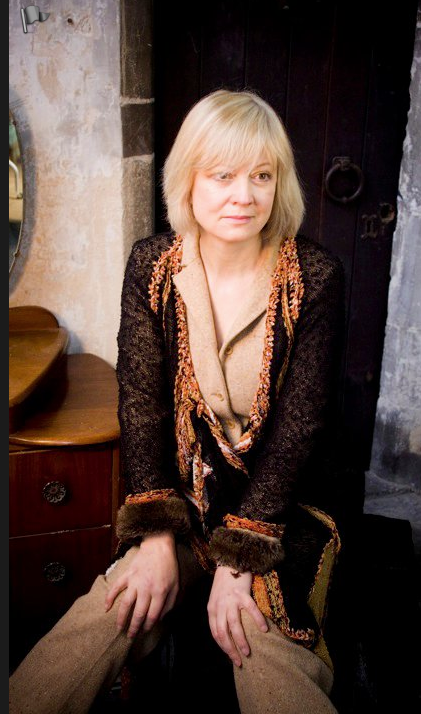
So going back to somebody new who wants to start out… How long will it take them to create something that is of the same quality… if they buy one of your patterns…
It depends on their enthusiasm, it’s like everything isn’t it? But I’ve had people, within a month, having never ever seen a knitting machine in their lives creating one of my designs. And I’m just talking about an hour, a couple of hours a week. I’m not talking about every day, it’s really quite quick.
Presumably it’s not a big investment?
No, no, basically because the knitting machine industry… because people didn’t show people how to use knitting machines about twenty years ago people were purchasing machines for about £500 (or more in fact). And the hardest part of starting to use any machinery is actually pushing the start button or actually in this case casting on and casting off, which is a manual process. So I make sure that people can actually do this and I won’t even show them the next step unless they can confidently and are happy about doing those processes. You’ve got to be able to start and you’ve got to be able to finish. The bit in between can be really quick. It’s like a whole skirt can take two hours but if you can’t get the first row on and you can’t get the last row off, you’re in trouble!
So basically, you used to do this in Norwich. You had a textile centre and people used to come to you and you used to train people?
I worked from home basically, bringing up my children, so people used to come to my home and they would see garments hanging up, they would try them on. They would say if they wanted them longer or shorter, or thinner or wider or whatever and I’d take my block like pattern and adapt that pattern for them and make it fit them. And that was all fine. But now I’m getting older, it’s a physical thing, it does take a strength, a physical strength to knit something for three or four hours – although you don’t have to do it straight off, you can do it over two days, five days, however long you like. But it’s now got to the point where three years ago I saw how many people were interested in machine knitting, but learning how to do patterns and wanting to learn how to make the shapes I make, so, I opened a textile centre. I ran it for two years and people seeing the finished products hanging up, definitely wanted to learn how to make them but they didn’t believe that they could. So it was a quest for me, it was a quest for them. A young twenty one year old who could hand knit a bit, crochet a bit, looks at a jacket that’s got a £400 price mark on it and says “I could never make anything like that!” And it was like “Yes you can!” And just slowly going through the paces.
And they did?
And they did and they are and they can! Because it’s not like there is a hidden agenda. It’s just as simple as it is. Ok when anything is new it’s complicated because you aren’t familiar with it. I mean you cast on once and you think urgh! Do it ten times and you can’t imagine that you could never do it. It’s the same with anything.
A little bit of practice, a little bit of patience.
Totally, practice is the thing.
You didn’t finish off saying about the costs.
Oh sorry, yeah. So, all these machines were out there. No one showed anyone how to use them, and I’m talking about thousands of knitting machines, in people’s houses, in their lofts, abandoned because of the economic thing. When women started going out to work, and then there were cheap imports, cheap clothes, so why bother to make your own? So, machines got abandoned and discarded. There are still plenty of old second hand machines out there – and they are very cheap!
It was popular in the idea of it, but it never really took off?
No. There is still the Guild of Machine Knitters but there’s not many young people doing it. Not many young people taking it up.
Because it came from a time when a lot of women did make their own clothes and for their children.
It came from a time when women were at home.
Well I remember my mum made, sewed a lot of clothes for us. She had a knitting machine but she didn’t use it.
And I think it’s like anything – it’s nice if we have encouragement. You go and invest in a piece of equipment and there’s no-one there to say “That’s great!” or that you’re doing it right or if you get stuck, how to get unstuck, then you are going to get stuck but if there is someone who can just literally unhook you, like I was at the Textile Centre.
It’s like on a computer isn’t it? You want someone in the background who can help you out.
And basically what I’ve said to other people is that I’m saving people from a 35 year learning curve. Because like, they’d have to work out what tension to put the yarn on but I can just tell them. They haven’t got to work it out themselves.
So this is all on your pattern. Where can someone get a pattern from?
They can get a pattern online from Etsy, I’ve got one at the moment being sold.
What’s Etsy?
Etsy is an internet shop for people who make clothes or make handmade things. They take pictures of them and they sell them at their chosen price.
So all I’ve done is take some pictures of the garments I’ve made, talked about them a bit with the price and people can buy them online. But now I’ve taken some of the designs that have proved to be successful and popular and have actually had patterns made for those designs with a view that people who have learned these different steps can actually look at any of my patterns now and in the future and they will be able to make it. They will have the skills and the tools necessary.
Can I take you to a different aspect of the House of Lavene? Do you have any prestigious clients?
We all are – we are all human beings!
But yes! A few that can’t be named! But yes I know for a fact that garments that I have made for people have worn them at different places like Ascot and most of the major venues and also one of my garments was worn at THE wedding in 2011.
The Royal wedding?
The Royal wedding in 2011 in fact! Yes, there are a few well know clients!
One story that came to light recently was that one of my clients was wearing her green dress to work and a writer in fact, was so amazed by how incredibly stunning my client looked that she decided she wanted one of these garments herself. She then included the dress in one of her short stories in her book which has just been published!
Your clothes are very, very unique and very different and very amazing.
To everyone else!
How can people that are reading this, how can they see some of your clothes?
I’ve got a Facebook page – Textile Lovers where, when I think about it I take a picture of something I’m making and put it up there. Or they can go onto my website www.houseoflavene.co.uk, where at the moment there’s not many pictures but there will be but also Etsy, which I try to renew when I can.
And you’ve got some photos on the Lovelli Flickr pages http://www.flickr.com/photos/lovelli/sets/72157627240254423/with/6026953496/
I live in Kent now and I’ve hired a gallery at The Beaney Art Museum in the centre of Canterbury from 23 March to the 7 April 2013. A big white gallery will be full of finished garments and showing the process basically from a cone of yarn to the finished garment and everything that it entails – a knitting machine, a knitting machine table, an ironing board and iron and some yarn and some enthusiasm really.
And you’re going to allow people to have a go at doing this themselves and also try on some of your work?
Yes. At least give them the chance to make the carriage go up and down and marvel, like I still do at how quickly it does grow, how quickly you can produce fabric and make a whole garment. And also show how to crochet.
There’ll be space to try on garments on a rail and look at yourself in a mirror and maybe even have your photo taken!
And you’re actually going to do a workshop?
Yes. So people can see me casting on and knitting and casting off and they can have a go at well.
So they can actually create something for themselves that they can take away with them?
Yes, a finished product from an hour and a half’s session.
And how much do these sessions cost?
They’re free!
So how do you get onto one of them?
You go to The Beaney website and register http://www.canterbury.co.uk/Beaney/whats_on/Designer-Knitting-House-of-Lavene.aspx
Get yourself enrolled so that you can be there on the day that I am doing all this. And watch and see and bring your questions and try on. There are two different aspects of it – learning upstairs in the Learning Lab for the workshop and downstairs in the front gallery seeing the garments and the process and trying things on. There will always be someone there to help you try things on in all different ways.
Well, I shall look forward to seeing your show at the Beaney at the end of March. Many thanks Annie for your interesting story.
Thank you!

